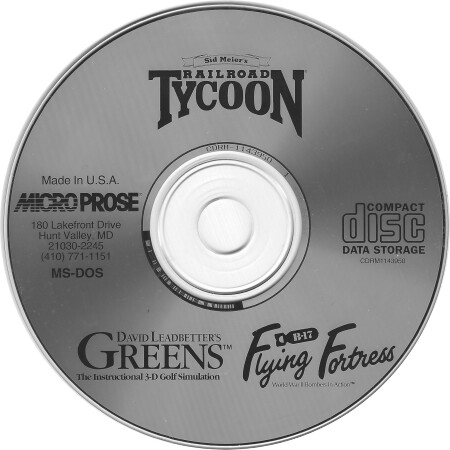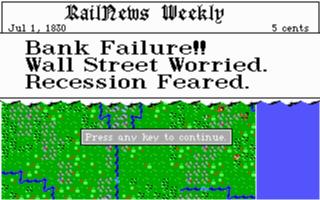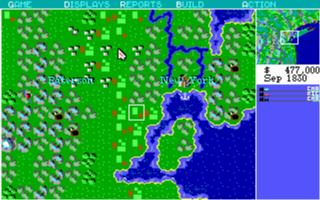
Actual Game
Railroad Tycoon1-Click Install
|
The Game
Sid Meier's Railroad Tycoon is a simulation of rare complexity. It re-creates the rise of railroading as it became perhaps the most powerful single industry in the world. The game is thorough and constructs a world so involving that it is easy to lose track of time and go into marathon mode.
Yet to its great credit, Railroad Tycoon never becomes bogged down by its considerable detail. Thanks to thoughtful program design and documentation that's entertaining and informative, MicroProse' s Railroad Tycoon achieves an impressive level of reality without sacrificing playability.
Railroad Tycoon simulates nearly every aspect of the rail business: You must survey land to find the best route for a new line; studying the resources of an area, linking supply and demand. You compete with other railroads, racing to lay track into the growing cities in your area. You also have to foster new industries, carefully planning and positioning track to take advantage of a factory's goods.
Attracted by such industrial opportunity, settlers will flock toward the stations you build along your railroads. The markets they create for passenger and mail transport further increase the wealth of your railroad monopoly.
The game casts you in the role of a hopeful entrepreneur with one million dollars in capital to invest in a new railroad. From there you're on your own, with only a map of the area in which you choose to play (Eastern U.S., Western U.S., England, or Europe), geographically accurate and ripe with resources. From these humble beginnings you must build your empire, battling competing railroads, playing the stock market - even buying the competition, siphoning cash from it, and taking over its routes.
Gameplay
Like all MicroProse sims, the difficulty settings you select will have a noticable impact on the game. The various skill levels, "Investor", "Financier", and so on determine advantage you have over the competition. At the easier levels your opponents have an advancement handicap, and market conditions are more lenient toward syou. At the highest skill level, however, the AI is unforgiving to all but the most experienced players. You then decide how you want train dispatching handled, whether you have a simple or complex economy and how friendly your competition is. Your selections determine the overall difficulty of the game.
You are given one million dollars in seed money with which to start your railroad. You can get more cash by selling 500,000 dollar bonds at various interest rates (depending on the current economic condition). It is best to survey the areas in the region of the world you have chosen to play in. You want to locate an area that is dense with cities as well as natural resources. Railroad transportation is a physical industry; geography, weather, hardware conditions, and so on, will directly affect your business.
After you pick a good starting area you begin to lay track. It is important to lay your track carefully. The early trains of the late 1860s were not very powerful so any land inclination grade over 1.75% will have significant impact on the overall speed of your trains. (The United States, incidentally, was unable to deploy extensive national railroads as early as it wanted because of this technical problem). Once you have connected one city to another, you need to build a station.
Railroad Tycoon cannot cover every intricate aspect of the business. Although it is a simulator it needs to be sufficiently generalized to be playable. Therefore, not every construction or hardware item used in the the industry of the 1800s will be represented. For example, the infastructure section focuses on the most important types of buildings: Switching Tower, Depot, Station and a Terminal. Each of these service the surrounding area; a network of these along your routes will allow your business to reach further across the country.
What's a station without a train to use it? When you build your first station you will also build a engine shop. This will be the manufacturing area for your different trains and allow you to upgrade depots, stations and terminals that you might build elsewhere along your track to have engine shops. As the game progresses you will learn the value of shrewd deployment of construction shops.
Moving right along, once the shop is ready for business, construction on a train begins. You are presented with a little animation of a engine exiting the engine shop. You then can add cars to the train and send it on its way. You can at each station change the 'consist' which is the list of cars your train is to pick up at the various stations along the way.
You continue to build tracks and linking city to city until either you run out of funds or the fiscal year ends. You might also consider buying treasury stock so that your investors can't fire you, or you might purchase stock from one of your competitors.
When the fiscal year ends you get your annual report. This report contains your income statement for the year, your balance sheet and the stock information. Study the stock information as it will tell you a lot. IF you see a stock suddenly rise you might want to invest in that railroad, or if you see stock prices fall you might want to sell your stock. Your stock holders are conscious of your stock decisions!
In one game I had a blast forcing a company out of business. The E&C railroad, ruthless monopolist that it was, relentlessly attempted to carve into my territory using price wars and other subversive tools. By taking control of the outfit via its public stock offering I was able to bleed income from the place until it could not pay its debts. Finally, in a touching gesture of concern for my respected colleagues at E&C, I dumped all of my stock causing the company to spiral into financial ruin as it vainly scrambled to save itself. Alas, I lost my shirt on the deal, but the satisfaction of a job well done was a much greater reward than money could ever be...
A game runs for one hundred years, after which you retire (I suppose one would grow tired of the same job after a century anway) and are given a rating. In typical MicroProse style the ratings evoke an image. In Tycoon they range from hobo to President of the United States. Railroad Tycoon is as addictive as they come and will challenge you to aspire to the highest rating. A final warning -- Be mindful of when you start a game as Raiload Tycoon suffers from Late Night Syndrome.
Sid Meier on Railroad Tycoon
"Railroad Tycoon was a neat idea. It basically paved the way for Civilization, in that I got the idea of taking multiple simple systems and having them work together to create an interesting complexity. There was operating the railroad, playing the stock market, building track. It was like different things that individually are pretty simple and easy to understand and easy to get into, that when they interact, create an interesting kind of complexity.
"We definitely played a lot of 1830 before we wrote Railroad Tycoon. I'd say we were halfway through the development, maybe two-thirds, before we added other railroads to compete against. We did a great deal of development just with the idea of you running the railroad more in a kind of SimCity sense; kind of like you've got something you're building and nothing else is really going on. But we found halfway through that if we added other competing railroads, it would really give this kind of edge to the game that it didn't have. Right now, you're kind of taking your time building a railroad - that old track over here, running trains - which was fun; it was fun in the model railroading sense. But adding that little element of competition makes every decision a little more interesting.
"So it was a long time before we added the idea of other railroads. You can kind of see in Railroad Tycoon, they're implemented in a very haphazard fashion. They don't follow the same rules as you do, and they're verging on the afterthought, but I think they have their effect, which is to add another dimension to all your railroad decisions, and then they introduce the stock market and the competition, which is a fun part of the game. I'm not sure exactly where the idea of the personalities of the computer opponents came from, but it's one that we've certainly used whenever, in Gettysburg and in other games. When you have an opponent, an AI, it's always fun to give them different personalities, especially if you can attach a face and a name to them. It's kind of one of those things that's not too hard to do, and it adds a lot of value to the game.
"Railroad Tycoon was also the first game I worked on with Bruce Shelley (Age of Empires). He was a great person to work with. What I found is that the good working relationships are with people that kind of fill in the holes - not two people that do the same thing and have the same skills, but two people that do complementary things. Bruce was a great guy to bounce off ideas. He had a lot of ideas. He was really interested in railroads and was very happy playing the game and giving me feedback and digging up facts and writing the manual. Really, all the things that I didn't do very well, he did well. So we kind of made a powerful team in that sense."
-- Sid Meier






